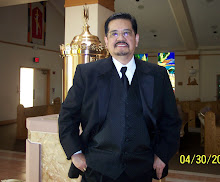My own daughter had given me in the past several books written by Bo. And then my niece gifted me with a couple more.
I like the style of writing of Bo; simple and humorous, so I continued to read his books.
Once an older person in church said that he'd like to see more Bo Sanchez's speak in the parish Bible seminars but then he added it seemed to him that Bo only speaks about happy times, and does not prepare his listeners or members of his prayer community for the bad times.
I didn't comment on this one because I haven't heard Bo Sanchez actually speak.
Yesterday we had the chance to hear Bo Sanchez speak.
We attended his Talk at the PICC Plenary Hall which centered on Solutions - Choose God’s Long-Term Solutions. This was the second of a three-part talk, Guaranteed: Three Things God Promises You: Supply, Solutions, Significance.
My seatmate to the left, a chubby boy who's probably eight or nine was so infectious. He'd say what Bo asked the audience to say, and ask what Bo asked the audience to ask, and sang along with the beautiful choir, complete with body and hand actions.
i
And looking around and above, I saw the same kind of enthusiasm and vibrancy from everyone.
Meanwhile a younger boy seated at the front who was playing a game in his cell phone earlier became attentive and sang when the choir led the song I am counting on God.
The Feast was a welcoming event. At the lobby of the Plenary Hall, members carried sign saying "Welcome First Time Attendees," and had easy smiles for everyone.
Ushers were friendly; so was everyone. First timers like us felt the immediate warmth and genuineness of the people around us.
In his talk, Bo Sanchez used live persons to clearly illustrate his point; it was highly effective. The gist: don't focus on your problem, instead, focus on your purpose. Ask for God solutions.
Before the Talk, Fr. Alex Balatbat celebrated the 10:45 am mass. He was energetic and gave an excellent homily on the Sunday Gospel reading.
After the talk, people milled around the lobby buying books and stuff. First timers were invited to join other first timers in small groups labelled "couples, singles, call center agents, etc." as prelude to joining "caring groups" or cg's. Caring groups meet during the week, and before and after the talk on Sundays.
On the way out, we saw caring groups huddled in meetings.
Physically, we were hungry when we left PICC as it was close to 2 p.m. but spiritually, we were completely fed.
In Bo Sanchez' own words, " Ultimately, I want to “franchise” the FEAST to the various parishes all over the Philippines—and around the world.
Through the internet, we’ll be video streaming the Manila FEAST to hundreds of similar gatherings in various parish churches, thus strengthening the parishes by giving their parishioners the option of attending the FEAST in their own local parish," said Bo.
Watch live video from The Feast on Justin.tv
















